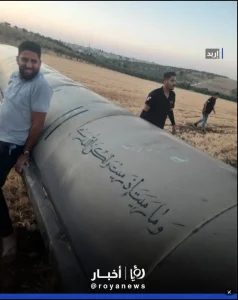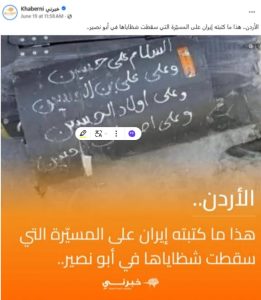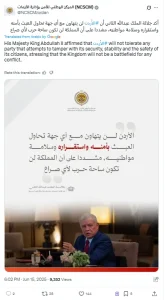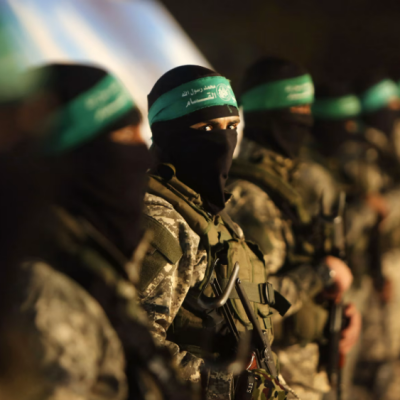In response to Israel’s “Rising Lion” operation, Iran launched an unprecedented wave of ballistic missiles, pairing kinetic force with religious symbolism to project moral authority and galvanize trans-Islamic solidarity. A detached Iranian missile booster was found bearing a verse from the Quran (Surah Al-Anfal 8:17):
“And it was not you who killed them, but God killed them. And it was not you who threw when you threw, but it was God who threw.”
﴾ فَلَمْ تَقْتُلُوهُمْ وَلَـٰكِنَّ ٱللَّهَ قَتَلَهُمْ ۚ وَمَا رَمَيْتَ إِذْ رَمَيْتَ وَلَـٰكِنَّ ٱللَّهَ رَمَىٰ ﴿ — سورة الأنفال، الآية 17
This inscription underscores the symbolic dimension of Iran’s missile strategy. By fusing theological narratives with military action, Tehran seeks to reframe regional deterrence as a sacred obligation—advancing its ideological leadership across the Islamic and Arab world, positioning itself as the vanguard of Islamic resistance, and challenging the legitimacy of Arab regimes that have normalized ties with Israel.
Drawing on Strategic Culture Theory (SCT), the integration of such verses imbues Iran’s missile doctrine with a claim of divine agency, transforming acts of war into sacred enactments of God’s will. This approach reflects a deeper strategic calculus: invoking divine sanction, reinforcing pan-Islamic identity, and mobilizing transnational support while reshaping regional narratives through symbolic warfare.
While the ballistic missile program may enhance national pride, the presence of this verse on a missile component found over Jordan illustrates Tehran’s deliberate effort to embed ideological messaging into military operations—mobilizing support, projecting divine legitimacy, and positioning its actions within a broader religious and geopolitical narrative.
Nonetheless, while this strategy bolsters Iran’s ideological stature among certain audiences, it faces significant constraints in Sunni-majority contexts and risks narrative fatigue. Counter-strategies are needed to mitigate its influence, preserve regional stability, and promote diplomatic alternatives.
 Figure 1. Iranian missile debris with Quranic verse found in Jordan June 14,2025
Figure 1. Iranian missile debris with Quranic verse found in Jordan June 14,2025
Background and Context
The 2025 escalation between Iran and Israel marks a pivotal intensification in a long-simmering confrontation shaped by proxy warfare, covert operations, and deep ideological rifts. What distinguishes this phase is Iran’s deliberate transformation of the battlefield into a stage for ideological projection. Ballistic missile salvos serve not only as demonstrations of kinetic capability but as instruments of symbolic warfare — missiles inscribed with Quranic verses and religious inscriptions that frame the confrontation through an eschatological and pan-Islamic lens, elevating military retaliation to the level of spiritual obligation.
More than a strategic asset, the ballistic missile program (BMP) symbolizes the convergence of military capability and ideological assertion. Iran’s deterrent posture reflects a hybrid of Western military doctrines and internal ideological imperatives — particularly Shiite martyrdom, revolutionary zeal, and a deeply rooted historical consciousness. This synthesis renders Iran’s missile deployments unpredictable and uncompromising, often leaving little room for negotiation. The missile becomes both a weapon and a message — delivering not only force, but meaning.
This was exemplified again on June 19, when a drone carrying religious inscriptions — “Peace be upon Hussein, upon Ali the son of Hussein, upon the children of Hussein, and upon the companions of Hussein” — fell over Abu Nseir in Jordan, reinforcing Iran’s strategy of embedding religious symbolism into its military arsenal.

Figure 2: Iranian missile with religious inscription verse found in Jordan June 19,2025
This strategy seeks to galvanize pan-Islamic solidarity and regional defiance, uniting disparate populations around shared narratives of victimhood, justice, and divine duty. This narrative has gained renewed momentum in the wake of high-stakes escalations, including Israel’s operation” Rising Lion” strikes on Iranian nuclear infrastructure and the targeted assassinations of senior military commanders such as Mohammad Bagheri and Hossein Salami, as well as prominent nuclear scientists. In retaliation, Tehran launched “True Promise-3“, an operation of missile salvos designed not merely to inflict damage, but to project divine mandate and ideological vengeance.
While Iran has officially denied direct involvement in earlier flashpoints — such as Hamas’ audacious October 7, 2023 attacks — its longstanding support for proxy actors like Hezbollah and Palestinian Islamic Jihad reinforces a consistent strategic narrative. By entwining military posture with religious legitimacy, Tehran seeks to assert ideological primacy in the Islamic world and cast itself as the authentic defender of Islamic sanctities in the face of Israeli aggression and Arab normalization.
Historical Precedents and Doctrinal Consolidation
This fusion of theology and firepower is not novel. In 2016, Iran launched missiles from the Alborz Mountains bearing Hebrew inscriptions such as “Yisrael Tsricha LeHimachek Me’Al Pnei Ha’adama” (“Israel must be wiped off the face of the earth”), echoing the language of Psalm 83:4. The intent was not merely to threaten, but to elevate the confrontation into a sacred narrative of eschatological struggle.
Even within Iran, this approach has been contested. In 2017, then-President Hassan Rouhani criticized the Islamic Revolutionary Guard Corps (IRGC) for such inscriptions, cautioning that rhetorical extremism could sabotage diplomatic negotiations — particularly the nuclear deal. This divergence reflected a deeper internal tension between revolutionary maximalism and pragmatic statecraft.
Nonetheless, the doctrinal trajectory has trended toward consolidation rather than moderation. The reappearance of Quranic inscriptions on ballistic missiles in 2025 signal the normalization of sacred deterrence — embedding religious ideology within Iran’s strategic arsenal as both shield and signal. The missile, once a tool of deterrence, now functions also as a vessel of divine proclamation.
Strategic Messaging, Religious Framing, and Ideological Projection
- Missiles That Speak
Iran’s missile doctrine increasingly merges battlefield action with symbolic religious messaging. These weapons are not launched in silence—they speak. By inscribing missiles with Quranic verses, Tehran transforms military retaliation into a theological proclamation, turning each launch into a statement that fuses divine justice with national and religious resistance.
- From Defense to Sacred Escalation
This messaging reflects a deeper evolution in Iran’s military posture. The Islamic Republic has shifted from a traditionally defensive stance to a defensive-offensive doctrine, granting itself ideological license to initiate preemptive or retaliatory strikes. In this recalibrated framework, escalation is sanctified, and Quranic injunctions are operationalized as mandates. The invocation of scripture legitimizes kinetic action as an expression of divine will rather than a mere act of statecraft.
- The Ballistic Missile Program as Ideological Arsenal
At the core lies Iran’s revolutionary strategic culture, where the ballistic missile program (BMP) serves as more than a tactical asset. Rooted in Shiite martyrdom, redemptive suffering, and revolutionary zeal, the BMP has become a vessel for ideological assertion. Missiles act as both deterrents and symbolic emissaries, delivering not only explosive power but also sanctified messaging.
- Moral Framing and Counter-Hegemonic Identity
Framing itself as a counter-hegemonic actor within the international system, Iran embeds military action within a moral narrative that casts deterrence as sacred duty. This layered strategy fuses theological rhetoric, ideological defiance, and emotional storytelling into a calculated communication apparatus — one designed not merely to punish adversaries but to shape regional perception, assert ideological leadership, and delegitimize opponents.
- The “Axis of Resistance” and Transnational Messaging
This narrative framework also reinforces Iran’s self-declared role as the ideological nucleus of the so-called “Axis of Resistance” — a transnational coalition of non-state actors including Hezbollah, Hamas, Huthies, and various Iraqi and Syrian militias united in opposition to Zionism, Western influence, and Arab normalization with Israel. In parallel, through initiatives like the “Shia Liberation Army,”— reportedly active in Latin America, North Africa, Central Asia, and South Asia — Tehran exports a deterrent doctrine rooted in ideological solidarity and military preparedness. This strategic network sustains the Islamic Republic’s internal power while expanding its prestige throughout the Muslim world.
- Sacred Imperative in Official Rhetoric
Official rhetoric further elevates this posture into a sacred imperative. Supreme Leader Ayatollah Ali Khamenei declared on X “With this crime, the Zionist regime has prepared for itself a bitter, painful fate, which it will definitely see” while President Pezeshkian vowed “powerful, legitimate response will make Israel regret”. These pronouncements reframe military retaliation as a moral obligation and position resistance as a principled stand against capitulation and compromise.
- Religious Symbols and Shiite Motifs
Religious framing remains central to this strategy. Tehran casts its actions as a defense of Islamic sanctities, mobilizing pan-Islamic sentiment by invoking collective outrage against Zionist aggression. Shiite-specific motifs — especially the martyrdom of Imam Hussein — offer theological legitimacy and historical continuity, enabling Iran to present itself simultaneously as both victim and avenger.
Even missile nomenclature reinforces this symbolism. Terms like “Khaibar” — referencing a 7th-century Muslim victory over a Jewish tribe — anchor present-day confrontation within a continuum of Islamic triumph. Such narratives are amplified through political theater, including choreographed funerals, mass rallies, and digital content that galvanizes younger, tech-savvy audiences.
- Emotional Mobilization Through Victimhood
To stir empathy and mobilize support, Iran emphasizes both Palestinian suffering and its own civilian casualties, particularly from Israeli strikes such as those targeting the Asatid-e Sarv Complex in Tehran. Visual content shared widely on social platforms humanizes these losses and amplifies public sentiment, reinforcing narratives of shared victimhood and resistance.
- Warfare as Moral Leadership
Such rhetoric elevates military action into a form of ideological crusade, casting Iran’s strategic choices as moral imperatives. The Islamic Republic presents itself as the last bastion of Muslim dignity and sovereignty, rejecting compromise and framing resistance as sacred duty.
Summary: Missiles as Airborne Sermons
In sum, Iran’s strategic messaging transcends conventional deterrence. It reframes warfare as moral leadership, transforming ballistic missiles into airborne sermons — inscribed with scripture and aimed not only at enemy defenses, but at the ideological terrain of the region itself.
Impact and Effectiveness: Resonance and Risk
Positive Outcomes for Iran
- Regional Mobilization
In Lebanon, Iraq, Yemen, and parts of the West Bank and Jordan, Iran’s religiously infused rhetoric resonates strongly — particularly among Shiite constituencies, pro-Palestinian Sunnis, and anti-Israeli segments of the population. This bolsters Tehran’s transnational legitimacy as the vanguard of Islamic resistance and cultivates support within its ideological orbit. - Internationalization of Conflict
Iranian officials, such as Foreign Minister Abbas Araghchi, have framed U.S. support for Israel as part of a broader imperialist campaign. Araghchi argued that “the United States could stop Israel’s attacks on the Islamic Republic with one phone call,” portraying escalation as a deliberate American strategy. Other Iranian voices allege direct U.S. logistical and intelligence support, reinforcing the perception of a coordinated anti-Iranian axis and attracting solidarity from non-aligned, anti-Western states. - Pressure on Rivals
By asserting itself as the uncompromising guardian of Islamic sanctities, Iran draws a stark moral contrast with Arab regimes — especially Egypt and Jordan — that share long borders and maintain peace treaties with Israel. As the Gaza war nears its second year, Tehran exploits mounting regional frustration and convert public outrage into political capital, presenting itself as the authentic defender of Palestinian rights and casting normalized Arab states as passive or complicit. - Strategic Posturing
The integration of religious inscriptions into missile design, combined with state messaging, reinforces an image of divine sanction. This elevates Iran’s deterrent posture among ideologically receptive audiences — particularly within Shiite communities across the Middle East, South Asia, and parts of Central Asia — who perceive resistance as both nationalist assertion and sacred duty.
Limitations and Risks
- Narrative Fatigue
In a region exhausted by prolonged wars and economic instability, Iran’s eschatological rhetoric faces diminishing resonance. While still effective among committed ideological circles, it fails to persuade centrist publics who prioritize national stability over regional confrontation. Iran’s Shiite identity further constrains its appeal, often evoking sectarian mistrust in Sunni-majority contexts. Tehran’s prior interventions in Syria, Iraq, and Yemen compound skepticism and dilute its moral authority. - Credibility Risk
Iran’s incendiary language — such as threats to “wipe Israel off the map” — risks narrative overreach when outcomes do not match rhetorical intensity. This gap could undermine Iran’s deterrent credibility. More seriously, the sanctification of missiles through Quranic inscriptions invites theological critique. If civilian casualties result from such strikes, the association of sacred texts with violence could provoke backlash from moderate clerics, undermining the Islamic Republic’s religious legitimacy and exposing it to charges of instrumentalizing faith for political ends.
Divergent Reception in Jordan
- Sovereignty Assertion: Jordan’s response to Iran’s missile activity underscores a clear and uncompromising stance on national sovereignty. His Majesty King Abdullah II firmly declared that Jordan “will not tolerate any party that attempts to tamper with its security, stability, and the safety of its citizens,” emphasizing that the Kingdom “will not be a battlefield for any conflict.” This statement reflects Jordan’s rejection of any effort to drag the country into broader regional hostilities and reaffirms its determination to defend its airspace against all hostile incursions — whether originating from Israel or Iran.

Figure 3: Statement on Platform X by Jordan’s Crisis Center quoting King Abdullah
- Public Alarm and Strategic Caution: The impact of Iranian missile debris on Jordanian soil generated alarm and renewed concerns about entanglement in the Israel-Iran confrontation. Rather than perceiving Iran’s rhetoric as Islamic solidarity, many Jordanians saw it as a destabilizing overreach. The episode underscored Jordan’s delicate balancing act: upholding support for Palestinian rights while carefully avoiding entanglement in wider regional escalation.
- Instrumentalization of Sacred Texts: Although no formal religious condemnation was issued, Iran’s use of Quranic inscriptions on missiles likely provoked unease among some Sunni scholars, intellectuals, and the public. Rather than fostering unity, such symbolism has been widely interpreted by observers as a politicized use of scripture. Moreover, Iran’s selective invocation of religious texts — seldom applied in defense of its own proxies like Hezbollah or in response to Israeli operations in Gaza —raising questions about whether Tehran’s messaging serves national interests more than pan-Islamic ideals.
- Information Warfare and Disinformation Campaigns: Iran-aligned digital networks launched targeted attacks on Jordanian leadership. King Abdullah II — himself a descendant of the Prophet — was portrayed as betraying Islamic solidarity. These narratives aimed to erode domestic legitimacy and frame Jordan’s neutrality as complicity with Zionism, weaponizing religious identity for political discrediting.
- Civil-Military Communication Gaps: The missile fallout exposed weak institutional messaging structures in Jordan. In the absence of effective civilian communication, the military assumed a public role in explaining defense operations. This shift highlighted a broader governance issue: the inability of political institutions and media to shape coherent national narratives during crisis, resulting in militarized message control and heightened public distrust.
- Broader Arab and Islamic World Reactions While Iran’s framing attracts support from segments aligned with the Palestinian cause, its broader regional appeal remains fragmented. Sectarian divides, geopolitical rivalries, and memories of Iranian interventionism — particularly in Syria and Iraq — limit its resonance across the Sunni-majority Arab world.
Evolving Narratives Under Pressure
As military tensions escalate and economic pressures mount, Iran’s strategic messaging may adapt in response to shifting internal and external dynamics. While religious motifs — particularly those centered on martyrdom, sacrifice, and redemptive suffering — remain a cornerstone of Iran’s ideological communication, they may be further amplified to sustain momentum, especially during periods of military risk or uncertainty.
At the same time, Iran’s recent battlefield successes — including precision strikes and coordinated retaliatory campaigns — have temporarily reinforced the credibility of its narrative framework. These actions have bolstered deterrence and demonstrated operational capacity, particularly to supportive audiences within the “Axis of Resistance.” However, the long-term viability of Iran’s ideological framework still depends on Tehran’s ability to align symbolic ambition with consistent strategic outcomes. Discrepancies between ideological rhetoric and lived realities — especially among younger, digitally literate publics — continue to pose risks to narrative cohesion and regime credibility.
Conclusion: Missiles as Mediums of Meaning
Iran’s missile strategy has evolved into a complex synthesis of theology, ideology, and strategic communication. These weapons are not launched in silence — they are airborne sermons, inscribed with scripture, designed to carry both explosive force and symbolic payload.
By embedding Quranic legitimacy into its arsenal, Tehran reframes deterrence as sacred duty and military resistance as moral leadership. While this rhetorical architecture resonates within certain ideological and sectarian milieus, its long-term sustainability hinges on disciplined narrative control and consistent symbolic efficacy.
As long as Iran’s missiles are seen not merely as tools of destruction but as divine proclamations — steel fused with scripture — its adversaries must confront a strategy crafted not just to destroy, but to define.
Bibliography
Adib-Moghaddam, Arshin. A Metahistory of the Clash of Civilisations: Us and Them Beyond Orientalism. Columbia University Press, 2012.
“Battle of Khaybar.” Wikipedia, Wikimedia Foundation, https://en.wikipedia.org/wiki/Battle_of_Khaybar. Accessed 21 June 2025.
“Detached Iranian Missile Booster Fired on Israel Inscribed with Quran 8:17 (Surah Al Anfal) Was Found in Northern Jordan.” Reddit: r/shia, Reddit, June 2025, www.reddit.com/r/shia/comments/1lb2wzs/detached_iranian_missile_booster_fired_on_israel/. Accessed 21 June 2025.
Miskimmon, Alister, Ben O’Loughlin, and Laura Roselle. Strategic Narratives: Communication Power and the New World Order. Routledge, 2014.
Ramazani, R. K. “Ideology and Pragmatism in Iran’s Foreign Policy.” Middle East Journal, vol. 58, no. 4, 2004, pp. 549–559.
Saleh, Alam, and Zakiyeh Yazdanshenas. “Iran’s Nuclear Messaging Campaign.” Middle East Institute, 15 Oct. 2024, https://mei.edu/publications/irans-nuclear-messaging-campaign. Accessed 21 June 2025.
“Table of Iran’s Missile Arsenal.” Iran Watch, Wisconsin Project on Nuclear Arms Control, 22 Feb. 2024, https://www.iranwatch.org/our-publications/weapon-program-background-report/table-irans-missile-arsenal
“US Can Stop Israel’s Attacks on Iran with ‘One Phone Call,’ Tehran Says.” Al Arabiya English, 16 June 2025, https://english.alarabiya.net/News/middle-east/2025/06/16/us-can-stop-israel-s-attacks-on-iran-with-one-phone-call-tehran-says
WION. Israel-Iran War LIVE: Iran Launches 19th Wave Of Operation True Promise-3 With Missile, Drone Barrage. YouTube, 21 June 2025, https://www.youtube.com/@WION . Accessed 21 June 2025.Yilmaz, Betul. “Iranian President Says ‘Powerful, Legitimate Response Will Make Israel Regret.’” Anadolu Agency, 13 June 2025, https://www.aa.com.tr/en/middle-east/iranian-president-says-powerful-legitimate-response-will-make-israel-regret-/3596991




